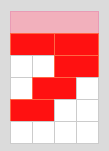Skip over navigation



Or search by topic
Number and algebra
Geometry and measure
Probability and statistics
Working mathematically
Advanced mathematics
For younger learners
Colour Building
Age 11 to 14
Challenge Level 





In this activity, you will need to use Cuisenaire rods, or the interactive Cuisenaire environment which you can find below. If you have not used the Cuisenaire Environment before, you might find it helpful to look at the instructions and video.
I wonder how many different ways there are of combining white rods (1) and red rods (2) to make the same length as the orange rod (10) ...
There are going to be quite a few, so let's start with a simpler challenge...
In how many ways can you combine white rods (1) and red rods (2) to make the same length as the pink rod (4)?
Once you think you've found them all, click below to check.
Using just red and white rods, there's only one way of making the same length as the white rod, and only two ways of making the same length as the red rod.
Without using the interactivity, can you work out how many different ways there are to make up the orange rod (10)?
Can you explain the pattern?
Extension
Try making different lengths using combinations of white, red and light green rods.
Can you use the patterns you observe to make predictions about how many ways there will be?
I wonder how many different ways there are of combining white rods (1) and red rods (2) to make the same length as the orange rod (10) ...
There are going to be quite a few, so let's start with a simpler challenge...
In how many ways can you combine white rods (1) and red rods (2) to make the same length as the pink rod (4)?
Once you think you've found them all, click below to check.
There are five different ways to make the same length as the pink rod:

Note that I count "white, white, red" and "white, red, white" as different, even though they both use two white rods and one red rod.

Note that I count "white, white, red" and "white, red, white" as different, even though they both use two white rods and one red rod.
Using just red and white rods, there's only one way of making the same length as the white rod, and only two ways of making the same length as the red rod.
Can you find all the ways of making the following lengths using just reds and whites:
- the light green rod (3)?
- the yellow rod (5)?
- the dark green rod (6)?
Without using the interactivity, can you work out how many different ways there are to make up the orange rod (10)?
Can you explain the pattern?
Extension
Try making different lengths using combinations of white, red and light green rods.
Can you use the patterns you observe to make predictions about how many ways there will be?
You may also like
Tea Cups
Place the 16 different combinations of cup/saucer in this 4 by 4 arrangement so that no row or column contains more than one cup or saucer of the same colour.
Painting Cubes
Imagine you have six different colours of paint. You paint a cube using a different colour for each of the six faces. How many different cubes can be painted using the same set of six colours?
Lesser Digits
How many positive integers less than or equal to 4000 can be written down without using the digits 7, 8 or 9?

